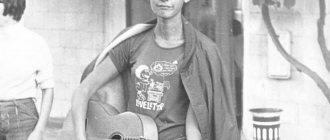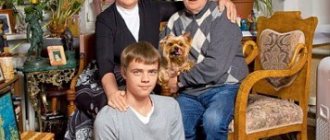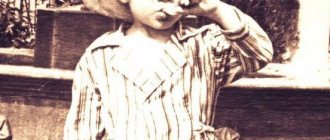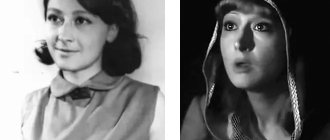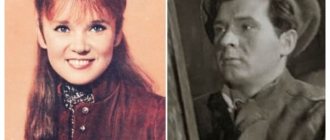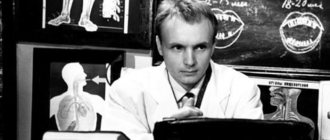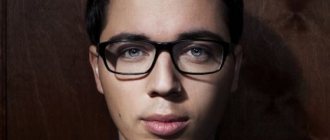Youth and first theatrical experiences
Oleg Efremov in his youth. Photo: persons-info.com
Oleg Efremov was born in Moscow on October 1, 1927. The first years of his life were spent in a large communal apartment on Arbat. Even as a child, the future actor and director became interested in theater: together with his cousin German Menshenin, he cut out figures of people and animals from paper, and then acted out various scenes in simple settings from scrap materials.
Oleg Efremov’s father worked as an accountant in the Main Directorate of Camps and Places of Detention - the Gulag. Due to his service, he, his wife and son had to move to Vorkuta in 1941. The family lived in the village of Abez, Vorkuta region, until August 1943. Nikolai Efremov did not like the fact that his 16-year-old son was communicating with criminals, so he decided to quit his job and return with his family to Moscow.
As a schoolboy, Oleg Efremov played in the drama club at the House of Pioneers on the old Arbat. The circle was led by Alexandra Kudashova, a student of theater director and teacher Mikhail Chekhov. At that time, Efremov was in close contact with Alexander Kaluzhsky, the grandson of the then famous Moscow Art Theater actor Vasily Luzhsky. It was Kaluzhsky who persuaded his friend to take exams at the Moscow Art Theater School in 1945. Efremov was accepted on the first try for a course with teachers Mikhail Kedrov and Vasily Toporkov.
In 1949, having received a diploma of higher education, he hoped to get into the Moscow Art Theater. But Efremov was not even hired as an extra at the famous theater. However, almost immediately the young actor was invited to the Central Children's Theater, which was then directed by the Moscow Art Theater actress Olga Pyzhova. Oleg Efremov made his acting debut on the stage of the Central Children's Theater - he played Volodya Chernyshev in the play “Her Friends” based on the work of playwright Viktor Rozov.
At the same time, the actor taught classes at the Moscow Art Theater School: Igor Kvasha, Galina Volchek, Oleg Tabakov, Evgeny Evstigneev studied in his course. In 1955, Efremov tried his hand at theater directing - he directed the musical comedy “Dimka the Invisible.” However, he did not give up acting either: in the same year, the play of the young director Anatoly Efros “Good Hour!” appeared in the repertoire of the Central Children's Theater, where Efremov played a young man from Siberia who came to study in Moscow.
Like many talented people, he had difficulty accepting other people's creative proposals. During the production of the play “Good Hour!” We sometimes argued for the entire four hours of rehearsal. The rest of the actors, without starting to rehearse, went home, and when they returned to the performance in the evening, they found us standing in the same position and continuing the argument.
Anatoly Efros
Oleg Efremov served at the CDT until 1957 and during this time he performed more than 20 roles - Mitrofanushka in “The Minor”, Molchalin in “Woe from Wit”, the Pretender in “Boris Godunov” and others. Gradually, a group of young actors, mostly his students, united around him. Initially, the association was called the “Studio of Young Actors,” but it was soon renamed the “Sovremennik” Theater Studio.
Unusual childhood and interesting acquaintances
The future actor was born in the capital in October 1927. The family lived in a communal apartment on Old Arbat, and the boy was friends with Seryozha Shilovsky, who was the son of M. Bulgakov’s third wife.
Oleg was also familiar with the legendary creator of The Master and Margarita himself.
When the Efremovs moved to Vorkuta, Nikolai Ivanovich began working in the Gulag as an accountant. And the boy learned from childhood what a camp was and observed the difficult life of prisoners.
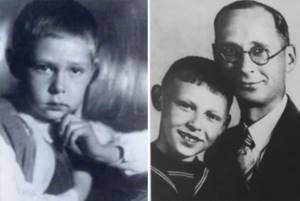
Oleg Efremov (on the right with his father Nikolai Ivanovich) in childhood
Later the family returned to Moscow. Here Oleg recalled his favorite hobby with his cousin - playing theater. They could spend hours making dolls and scenery from scrap materials, acting out scenes and rehearsing. The young man entered the theater club at the House of Pioneers.
A close friend Alexander, the son of theater star Vasily Kaluzhsky, suggested that Efremov, after graduating from school, apply to the Moscow Art Theater School.
"Contemporary"

Oleg Efremov. Photo: aif.ru
The first production of the new theater, directed by Oleg Efremov, was in 1956 a performance based on the play “Forever Alive” by Viktor Rozov. The audience, judging by the reviews, expected more from the young actors: “The performance is wonderful, of course, but you showed us just a good Moscow Art Theater.” However, Efremov took such statements as praise: the traditions of the old Moscow Art Theater were precisely its main ideal.
At one time, Oleg brought us together for the sake of a single idea: to engage in psychological theater - one in which there will be a nerve, a thought, a soul. Of course, in the most varied forms, but under an indispensable condition: so that the content is not lost behind the form. And he ignited us so much with this idea, gave us such a powerful start, believed in us so inspiredly and was so ruthlessly demanding that this charge still suffices to this day.
Galina Volchek
Already in 1960, the troupe went on tour to Leningrad to gain popularity outside of Moscow. The next year was “nomadic” for the actors: the theater did not yet have its own building, there was nowhere to store props and costumes, and constantly transporting bulky and fragile scenery was too difficult and expensive. We played all the time at different venues. When Sovremennik was given a building on Mayakovsky Square in 1961, the actors retained the habits that they were forced to follow on tour. Thus, there was no curtain in the theater, and the performances were designed extremely laconically.
In 1964, Sovremennik was recognized as a professional theater - the word “studio” disappeared from its name. By this time, the repertoire already included more than a dozen performances based on works by contemporary authors - “The Naked King” based on the play by Evgeniy Schwartz, “The Continuation of the Legend” and “Two Colors” by Anatoly Kuznetsov, “According to Moscow Time” by Leonid Zorin and others. Viktor Rozov remained one of Oleg Efremov’s favorite playwrights: Sovremennik’s repertoire included his plays “On the Wedding Day,” “In Search of Joy,” and “Eternally Alive.”
The art of theater is modern in its essence, because today it is happening - right this very second - it cannot be fixed in any way. Then it will be a different art.
Oleg Efremov
Efremov led Sovremennik until 1970. His last production on this stage was Chekhov's The Seagull.
Artistic director of the Moscow Art Theater

Oleg Efremov. Photo: kino-teatr.ru
Oleg Efremov had a second chance to get into the Moscow Art Theater 21 years later: on September 7, 1970, he was appointed chief director of the Moscow Art Theater. Following him came from Sovremennik and some of his students - Evgeny Evstigneev, Andrey Popov, Alexander Kalyagin. The famous theater was going through hard times at that time: the troupe included about 150 artists, some of whom were not involved in performances at all, but received salaries on the same basis as the frequently performing actors. Spectators were reluctant to go to the Moscow Art Theater, preferring Taganka or Lenkom. An era of stagnation began in the development of the theater.
During the first year of work, Efremov personally talked with each actor and came to the conclusion: “I realized that many mkhat players have one overarching goal - to maintain their own peace.” After this, reforms began: the new artistic director introduced plays into the repertoire that had not been staged before, established a “council of elders” consisting of the most experienced actors, and tried to involve as many artists in the performances as possible. Almost the entire troupe participated in the first nine productions of the renovated theater.
The main thing that Oleg Nikolaevich strove for was for there to be a living person on stage, and not a buffoon depicting life, so that the life of the human spirit reigned in the theater, as bequeathed by the great Stanislavsky, whose faithful and persistent admirer Efremov himself was until the end of his days.
Actor Vyacheslav Nevinny
In 1971, Efremov staged the play “Dulcinea Toboso” based on the play by Alexander Volodin. This production still complied with the traditions of Sovremennik - simplicity of perception, the illusion of direct communication with the viewer. Other plays appeared at the Moscow Art Theater at that time - poignant, topical stories from Soviet life. These included the works of playwright Alexander Gelman, which Efremov later turned to - “Feedback”, “Meeting of the Party Committee”, “Alone with Everyone”.
The classics did not leave the repertoire either - “The Seagull”, “Uncle Vanya” and “Three Sisters” by Anton Chekhov, “The Last” by Maxim Gorky. Efremov was not afraid to experiment with productions: he swapped episodes, shifted accents, and brought secondary characters to the fore. Invited directors often worked with him: Anatoly Efros staged “Tartuffe” at the Moscow Art Theater, Lev Dodin staged “The Golovlev Lords” based on the work of Mikhail Saltykov-Shchedrin. Efremov collaborated not only with eminent theater figures, but also with novice directors - Kama Ginkas, Roman Viktyuk, Mark Rozovsky.
Meanwhile, a split was brewing in the theater. The troupe again became too numerous; Efremov had to stage many small, run-of-the-mill performances, which were of little interest to the public, but allowed them to occupy most of the actors. Artists with little work believed that they were being unfairly assessed. For some, this was the reason for leaving the theater: this is how Georgy Burkov and Alexey Petrenko left the Moscow Art Theater.
Gradually the troupe split up. To smooth out the conflict, in 1987 Oleg Efremov proposed creating two autonomous divisions of the theater - the main Moscow Art Theater in Kamergersky Lane and a branch on Moskvina Street. But as a result, two groups independent from each other were formed: the Chekhov Moscow Art Theater, whose leader remained Efremov, and the Gorky Moscow Art Theater, which was headed by Tatyana Doronina.
Theater
At the CDT, the young actor was immediately given the main role. He appeared on stage as Volodya Chernyshev in the production of “Her Friends” by Viktor Rozov and was loved by the audience from the first performance. Efremov played so sincerely that no one saw him as an actor, but they saw him as a living, real schoolboy.
Soon the CDT became one of the most popular theaters in Moscow. Efremov played more than 20 roles on his stage. The actor equally brilliantly managed to transform into the Pretender in “Boris Godunov” and into Ivan the Fool in “The Little Humpbacked Horse.” And in 1955, Oleg Efremov himself staged the musical comedy “Dimka the Invisible” by Mikhail Lvovsky and Vadim Korostylev. The director's debut was a brilliant success for the then-famous actor.
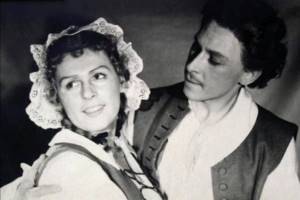
Oleg Efremov in the play “The Bourgeois in the Nobility”
The Stanislavsky method, to which Efremov swore eternal allegiance as a student, had by that time become unfashionable in theater circles, but the actor, faithful to his oath, found like-minded people among the students of the Moscow Art Theater School. After graduating from the studio, Efremov remained as a teacher there, and the students loved him very much. From them he assembled the first troupe of the future Sovremennik Theater.
“Contemporary” fully lived up to its name. The theater raised the most pressing issues. Plays by contemporary authors were performed on its stage, including Alexander Galich, Vasily Aksenov and even Alexander Solzhenitsyn. It was an honest, live communication with the audience. There wasn't even a curtain in the theater.
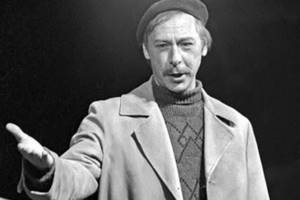
Oleg Efremov on stage
Efremov, being the director of Sovremennik, always remained its actor. He set the tone and determined the style of the theater, and all the other actors imitated him. In 1970, Oleg Efremov was invited to become artistic director at the Moscow Art Theater. An ambitious dream, once recorded in a student diary, has become a reality.
True, reality turned out to be completely different from what it seemed in my youth. Efremov was invited to the collapsing Moscow Art Theater as, in essence, a crisis manager. He suggested that the entire Sovremennik troupe move to the Moscow Art Theater, but only Evgeniy Evstigneev agreed. Over time, the new artistic director gradually managed to restore the theater's former glory and lure Alexander Kalyagin, Innokenty Smoktunovsky, and then Tatyana Doronina there.
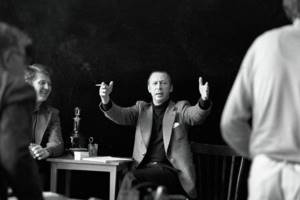
Oleg Efremov in the theater
The Moscow Art Theater troupe became so large that there were not enough roles for all the actors. In the end, Oleg Nikolaevich proposed dividing the theater. So he became the head of the Chekhov Moscow Art Theater.
A real blow for Oleg Efremov was the death of his beloved actor Innokenty Smoktunovsky. After that, the director staged only one play at the Moscow Art Theater - “Three Sisters”. And 6 years later, Efremov left after Smoktunovsky. His theater was at that moment thousands of kilometers away - on tour in Taiwan. Fans of the talent, without exaggeration, of the great actor and director brought him so many flowers at parting that it was impossible to approach the Moscow Art Theater building on Kamergersky Lane.
New solutions by Efremov

Oleg Efremov. Photo: sovremennik.ru
At first, confusion reigned in Oleg Efremov’s new theater: it turned out to be too difficult to harmoniously divide not only the collective, but also the repertoire into two parts. Efremov refused to stage passable, irrelevant performances and works that were not interesting to him, and this caused new protests in the troupe. Anastasia Vertinskaya, Ekaterina Vasilyeva, Alexander Kalyagin and other famous actors left the Chekhov Moscow Art Theater. The death of Innokenty Smoktunovsky in 1994 was a great tragedy.
Efremov also failed to find a new interesting playwright from among contemporary authors, so he focused on productions of classical works. On the stage of the Chekhov Moscow Art Theater there were “The Cherry Orchard”, “Boris Godunov”, “The Seagull”, and some works by Alexander Gelman and Leonid Zorin from the old repertoire.
Oleg Efremov’s last production was the play “Three Sisters” in 1997. It delighted the public and critics. The director deviated from the usual canons of this performance: for example, the final scene, according to his idea, took place in the park, with no house visible in the background. “The play is about a home, but there is no home, this is deep pessimism.” — a journalist from Great Britain spoke about this. “This is not pessimism, this is life,” Efremov answered her.
Oleg Efremov in cinema
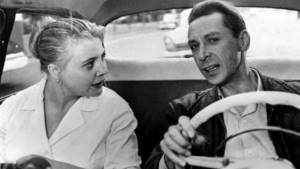
Still from Tatiana Lioznova’s feature film “Three Poplars on Ivy” (1968)
Unlike many fellow directors, Oleg Efremov never gave up acting. He played in almost all performances of Sovremennik, performed 14 roles at the Moscow Art Theater and the Chekhov Moscow Art Theater. At the same time, he acted in films, although at first he was skeptical about this type of art, believing that such work was detrimental to the talent of a theater actor.
Efremov's film career began in 1955: he played Alexei Uzorov in the film “First Echelon”. This was the role of the ideal Soviet person - a Komsomol member, an exemplary Soviet citizen. After this, Efremov more than once reincarnated himself into similar “correct” heroes - security officers, party leaders, criminal investigation officers. He even played Felix Dzerzhinsky in Sergei Yutkevich’s film “Stories about Lenin.”
However, the audience remembered and fell in love with Efremov’s lyrical images. In 1965, he played Fyodor Dolokhov in War and Peace - a demoted officer, a handsome man, a rake and a lover of playing evil jokes on others. The next famous role was the good doctor Aibolit from the children's fairy tale “Aibolit-66”.
In 1966, Eldar Ryazanov’s comedy “Beware of the Car” was released. In it, Efremov played the role of investigator Maxim Podberezovikov, who in his free time plays in an amateur theater, and in his office, instead of a portrait of Dzerzhinsky, there is an image of Stanislavsky. “On the one hand, his acting personality is characterized by traits that an investigator is supposed to have, that is, a steely gaze, a decisive gait, a confident gesture, a strong-willed face. On the other hand, the actor had self-irony, which allowed him to play as if not seriously, emphasizing a slight condescension towards his character,” said Ryazanov. A year later, the film “Three Poplars on Plyushchikha” appeared, in which the actor played taxi driver Sasha.
Colleagues noted that Efremov performed all his roles naturally and simply, easily getting into the character. In the theater he almost did not use makeup. Viewers mistakenly believed that in all contemporary heroes the actor simply played himself, but in the cinema he just as naturally “entered” the image of Dolokhov. This was Efremov’s own artistic tradition - to play without practically playing.
Oleg Efremov’s last film work was the ten-episode film “Chekhov and Co,” released in 1998. In it, the actor played two roles at once - Savva Zhezlov’s father in the short story “Holy Simplicity” and the landowner Kamyshov in the story “In a Foreign Land”.
Film roles
He did no less for the theater than for cinema. Since 1955, the actor has starred in more than one hundred films. Eyewitnesses claimed that he could play almost any role with equal success. Efremov was both the artist from “Shine, Shine My Star”, and the kind Doctor Aibolit from the film “Aibolit-66”, and Dolokhov from “War and Peace”, and the investigator in love with the theater from “Beware of the Car”. All his roles worked out equally well for him.
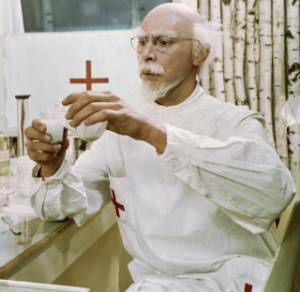
Interestingly, Oleg Efremov starred with his son Mikhail in the film “When I Become a Giant” when he was still a teenager, and this film made Efremov Jr. famous throughout the USSR.
Personal life of Oleg Efremov
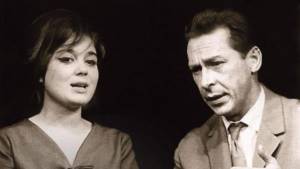
Oleg Efremov and Nina Doroshina. Photo: nastroenie.tv
Oleg Efremov was considered an attractive and amorous person. At different times he had short affairs with Anastasia Vertinskaya, Galina Volchek, Irina Miroshnichenko, Nina Doroshina. However, none of them developed a family.
Efremov's first wife was actress Lilia Tolmacheva. Their marriage did not last long, there were no children together. However, even after the divorce, the couple maintained a warm relationship, even forming a strong creative union: Efremov invited Tolmacheva to Sovremennik, and she soon became a leading actress.
In 1955, Efremov met 19-year-old journalist Irina Mazuruk. They did not officially marry, but lived together for three years. They had a daughter, Anastasia, who later became a theater critic.
Efremov’s third and last wife was actress Alla Pokrovskaya. They got married in 1962, and soon the couple had a son, Mikhail, a future actor.
Oleg Efremov died on May 24, 2000 in Moscow. He was buried at the Novodevichy cemetery, next to the grave of Konstantin Stanislavsky.
Personal life
Oleg Efremov was famous for his amorousness and himself attracted millions of Soviet beauties. The actor's first love was Tanya Rostovtseva. The girl was two years younger than the artist. When she grew up, she married Yuri Nikulin.
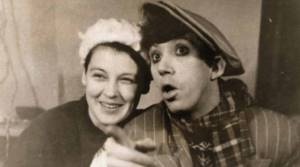
Tatyana Rostovtseva and Yuri Nikulin. Photo: liveinternet.ru
At the Moscow Art Theater School, Efremov fell in love with actress Irina Skobtseva, but she preferred someone else. As a result, the rejected Efremov married Lilia Tolmacheva. The marriage lasted six months. Oleg Nikolaevich did not worry about the separation and instantly fell in love with Margarita Kupriyanova, who played with him in the play.
The director's next muse was Antonina Eliseeva. But their relationship never reached a new level. In 1955, the artist’s friend Galina Volchek introduced Efremov to the granddaughter of the polar pilot Irina Marzuk. The woman gave birth to the actor’s daughter Anastasia. Oleg Nikolaevich cheated on his wife. Everyone knew about his affair with Nina Doroshina. Irina Marzuk even made an attempt to talk with Doroshina, meeting her in the theater corridor. When the woman realized that this was not helping, she began to accept the advances of other men. And after Oleg Efremov left the family, Marzuk wanted to commit suicide.
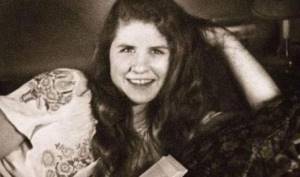
Irina Marzuk. Photo: uznayvse.ru
Efremov and Doroshina broke up many times and got back together. The actress got tired of waiting for the first step from Oleg Efremov and out of spite married Oleg Dahl. Then Efremov came to the newlyweds at the wedding and announced that the bride loved him. Two months later, Dal and Doroshina divorced.
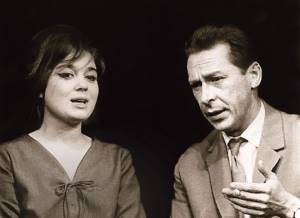
Nina Doroshina and Oleg Efremov at the Sovremennik Theater. Photo: uznayvse.ru
But Oleg Efremov was in no hurry to marry the artist who loved him. Anastasia Vertinskaya also pinned hopes on marriage with the artistic director. The actress even made renovations in Efremov’s apartment. But Oleg Nikolaevich did not marry her either. Then he had vivid novels with Irina Miroshnichenko and Iya Savvina.
But in 1962, Oleg Efremov still got married. His last official wife was Alla Pokrovskaya, the daughter of theater figure Boris Pokrovsky. In this marriage they had a son, Mikhail.
Mikhail Efremov followed in his father’s footsteps, choosing the theatrical path. His son Nikita is also a theater and film actor. Anastasia Efremova works in the Union of Theater Workers.
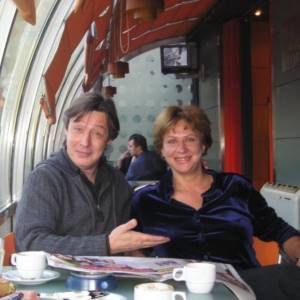
Children of Oleg Efremov: Mikhail and Anastasia. Photo: vokrug.tv
Interesting facts from the life of Oleg Efremov

Oleg Efremov. Photo: life-artists.ru
1. As a child, Oleg Efremov was friends with the adopted son of Mikhail Bulgakov, Sergei Shilovsky. The actor recalled that he often visited the writer’s house, but did not realize the full significance of such meetings: “Of course, I don’t remember the owner of the house himself, but the atmosphere of a wonderful, cheerful, intelligent family remained in my memory... At that time I had no idea about “Days” Turbins”, neither about “Molière”, nor about the head of this house himself... It’s just that Bulgakov’s house turned out to be a part of life, a “harbinger” of a meeting with the Art Theater.”
2. In the play “Decembrists” Efremov played Emperor Nicholas I. Once on stage he made a slip: instead of the line “I am responsible for everyone!” - said: “I am responsible for the light!” Efremov’s partner, Evgeny Evstigneev, was not at a loss and replied: “Then for gas, Your Majesty!”
3. In the film “Beware of the Car,” Eldar Ryazanov first saw Efremov in the role of the main character, the “noble thief” Yuri Detochkin. However, after looking at the test results, Ryazanov’s co-author Emil Braginsky exclaimed: “This is a wolf in sheep’s clothing!” As a result, Efremov played investigator Podberezovikov, and the main role was given to Innokenty Smoktunovsky.
4. Efremov was in love with Nina Doroshina. They broke up several times and resumed their relationship, until finally Oleg Dal proposed to the actress. The offended Efremov challenged Dahl to a real duel. Fortunately, everything ended quite peacefully: the rivals were able to reach an agreement without the use of force.
Oleg Efremov: biography
The legendary Soviet actor, director, teacher and founder of the Sovremennik Theater Oleg Efremov was born in a large Moscow communal apartment on Arbat. His best friends were the grandson of the legendary Soviet actor Vasily Kaluzhsky, Alexander Kaluzhsky, and the adopted son of the writer Mikhail Bulgakov, Sergei Shilovsky. As a child, Oleg often visited the Bulgakovs’ house on Nashchokinsky Lane. He absorbed the intelligent creative atmosphere like a sponge, not even suspecting what a great person he was lucky to communicate with. Little Oleg had not yet read a single book by Bulgakov. But then, of course, he made up for lost time by staging more than one of Bulgakov’s works in the theater.
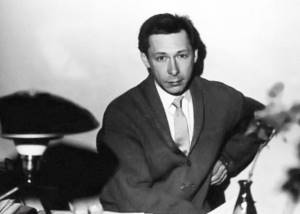
Oleg Efremov in his youth
Efremov spent his school years in Vorkuta. His father worked as an accountant in the Gulag, so his son saw real camp life quite closely.
Immediately after the war, Oleg went to take exams at the Moscow Art Theater School. There were an incredible number of people wishing to enter the acting department, but the ugly eighteen-year-old boy managed to conquer the admissions committee and pass the competition on the first try. Efremov was lucky to get on the course of the outstanding Soviet theater director, winner of four Stalin Prizes, Mikhail Kedrov, and the no less outstanding Soviet actor and director, winner of two Stalin Prizes, Vasily Toporkov.
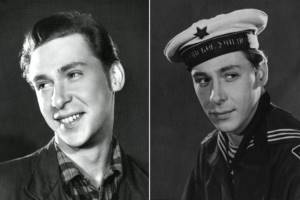
Oleg Efremov in his youth
With all his youthful ardor, freshman Efremov fell in love with Stanislavsky’s teaching, so much so that, together with his classmates, he swore eternal allegiance to him. For greater seriousness, the future actors sealed the oath with their own blood. And Efremov was faithful to her until the end of his days.
Oleg threw himself into his studies, dreaming of the Moscow Art Theater. The ambitious student wrote in his diary that he would become the main director of the famous theater, but after graduating from the studio school he was not even hired there as an extra. It was a complete failure. But he did not despair and joined the Central Children's Theater.
